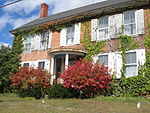Lebanon High School (New Hampshire)
1922 establishments in New HampshireEducational institutions established in 1922Lebanon, New HampshirePublic high schools in New HampshireSchools in Grafton County, New Hampshire
Lebanon High School is the sole high school in the Lebanon School District (SAU 88) in New Hampshire. Ranging from grades 9–12, students are from the city of Lebanon and the towns of Grantham, Plainfield and Cornish.The mascot for the LHS Raiders is commonly called the "Raider Bird."
Excerpt from the Wikipedia article Lebanon High School (New Hampshire) (License: CC BY-SA 3.0, Authors).Lebanon High School (New Hampshire)
Heater Road, Lebanon
Geographical coordinates (GPS) Address Nearby Places Show on map
Geographical coordinates (GPS)
| Latitude | Longitude |
|---|---|
| N 43.653055555556 ° | E -72.249444444444 ° |
Address
Lebanon Schools
Heater Road
03766 Lebanon
New Hampshire, United States
Open on Google Maps





